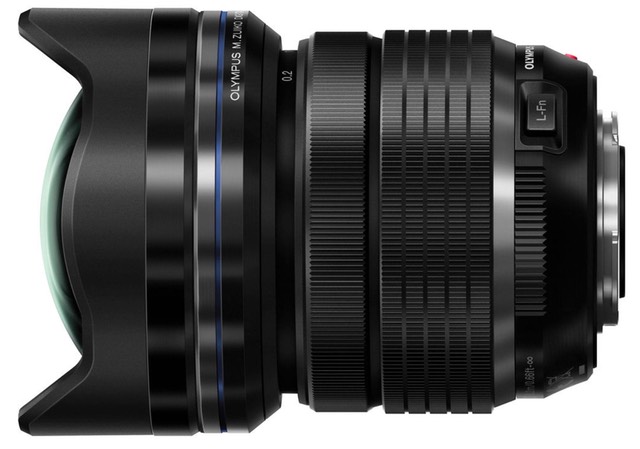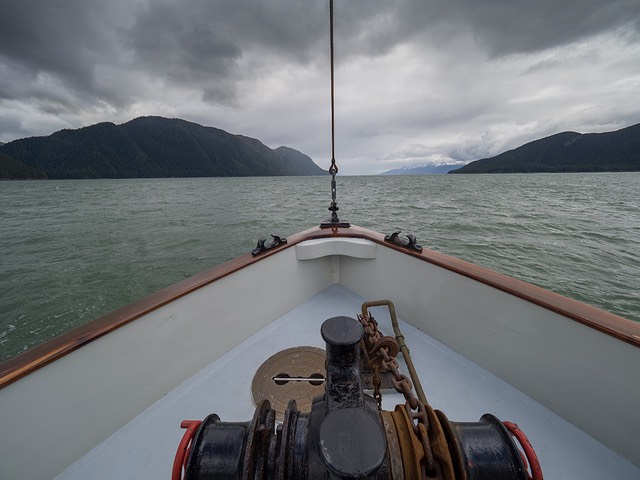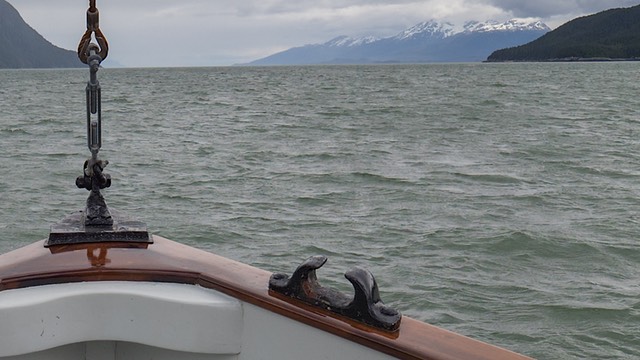
What is It?
The 7-14mm f/2.8 is a pro-caliber, very wide angle, zoom lens, equivalent to a 14-28mm lens on a full frame camera. This provides a 75-115° angle of view across the diagonal, which is about as wide as a non-fisheye lens gets these days.
As part of the Olympus Pro series, the 7-14mm is weather sealed and made with a metal body, and its optical construction gets quite complex: 10 of the 14 elements are aspherical or low dispersion glass. The frontmost element is the usual bulbous glass one you typically find on these very wide angle lenses, and the petal lens hood is built in and not removable. Olympus provides a slip-on lens cap that locks to the hood, which is better than the slip-on only style a lot of competitors use (e.g. the Panasonic 7-14mm f/4).
Close focus is 8" (.2m), and manual focus is achieved by pulling the focus ring back towards the camera and disengaging the autofocus clutch. That ring reveals minimal markings when pulled back for manual focus (1 and 2 feet, and .2, .4, and 1m, as well as infinity). It takes just a bit over a quarter turn to go from minimum focus to infinity.
The zoom ring also goes from minimum to maximum in about a quarter of a turn, with markings at 7, 8, 9, 10, 12, and 14mm.
Overall, the lens isn't particularly large, measuring just 4.2" (105.8mm) in length and 3.1" (78.9mm) in diameter. Weight is just over a pound at 18.8 ounces (534g).
The lens has an L-Fn button, but does not have IS. Surprisingly, the aperture diaphragm is only 7 blades.
The lens is made in China and comes only in an all-black finish. A small soft case is included in the box.
Olympus' Web page for the lens.
Source of the reviewed lens: borrowed from B&H.
How's it Handle?
This is going to look familiar to some of you, mainly because it's virtually the same words I used for handling on my review of the 12-100mm f/4 Pro lens! Yes, Olympus is making the Pro lenses so much the same, that sometimes handling turns out to be identical.
On the smaller m4/3 bodies—e.g. the E-M10 or GM models—this lens creates a slightly front-heavy combination that's a little out of balance. On the bigger m4/3 bodies—e.g. the E-M1 Mark II or GH5—the 7-14mm f/2.8 is a perfect match and provides a very nice body/lens balance.
I have a bit of a love/hate relationship with the manual focus clutch style this lens uses. I love the ability to just pull back into manual focus, and the manual focus ring on this lens is very smooth when I do that. It reminds me of the great old film lenses Olympus made when manual focusing. But I did note that the clutch got accidentally disengaged a lot when I was putting the camera into or pulling the camera from the bag. Too often I'd hit the back button for autofocus and nothing would happen. Yep, clutch disengaged again.
The funny thing is that the clutch requires some real effort to move and makes a snap noise when you do, yet somehow I often found the clutch in the wrong position without me noticing how it got there. Can't say it's a real drawback, and it may be the rough handling that my gear goes through on my travels, but it's something to be aware of.
The L-Fn button is in perfect position if you use the classic under lens form with your left hand. You'll find your left thumb finds the button easily, something that isn't always the case with lens function buttons. Well done, Olympus.
The zoom ring is on the stiff side, but smooth, exactly the way I like it. There's no zoom creep when you point the lens down. It's also easy to distinguish the zoom ring from the focus ring, even though the two are close together.
Overall, the 7-14mm f/2.8 handles pretty much the way I'd want it to. At least on the bigger m4/3 bodies.
How's it Perform?
Focus: As with most wide angle lenses, autofocus performance is snappy as long as there's clear detail at the focus sensor. With really wide lenses like this, very distant features may not supply enough detail and thus start acting as if they're on low contrast subjects, but I never really encountered that problem. Moreover, it's tempting to just use this lens focused manually at hyperfocal distances, as at 7mm and f/2.8 you can put the pointer at 2m and get everything from just over two feet (.8m) to infinity within the depth of field (using Olympus' figures; I'd say more like four feet (1.6m) to infinity using hypercritical analysis). It would have been nice to have a "snap to" hyperfocal setting on the focus ring.

One typical use of such a lens (at 7mm). This is the galley area of the boat I spent a week on in Alaska recently. I've not attempted to correct any perspective distortion, though the lens corrections have been applied for the linear distortion here (and you can still see that slight barrel distortion that gets left).

Another image at 7mm. It looks like there's a lot of distance between the anchor winch and the front of the boat. Nope. I can barely fit in there. Meanwhile, at f/5 the lens is managing to keep the front of the boat and the very distant mountains within critical focus:

Sharpness: I was very surprised at the central sharpness of this lens. Very surprised. Wide open it may be my sharpest m4/3 zoom I've tested in the central region, and that's at 7mm and out to about 10mm. Exceptional performance. At 14mm wide open, the center sharpness falls off just a bit wide open and f/4 is the best aperture. Still excellent performance in the middle of the frame, though.
It's difficult to say exactly how good the corners really are, though, because this lens has very significant field curvature at 7mm (but ignorable at 14mm, I think). Testing on flat charts obviously doesn't produce usable information in the corners at close distances. At any focus plane distance of less than 50 feet or so (15m) this lens really needs adjustment to pull in the corners at the wider focal lengths. Thus, we have to go to field checks, which can be a bit unreliable as subjects vary, and require some care to get best results. In general, I'd be stopping down—certainly to f/5.6, but even to f/8—and pulling the focus point ever so slightly forward (towards the camera) if I wanted to achieve best possible landscape shooting results with this lens in the corners.
This performance reminds me a lot of the Nikkor 14-24mm f/2.8: some people don't think that lens performs all that well, but that's because they're trying to make it capture flat fields and aren't compensating for the field curvature.
I guess if I had to be pressed on providing a subjective conclusion on the corners for the 7-14mm, I'd call them only good to very good, and then only if you've got the right subject, focus point, and depth of field. This isn't really a lens for in-city architecture.
Coma and spherical aberration is reasonably well corrected. In star fields, there's a bit less distortion than I'm used to with lenses this wide, even with the field curvature taken into account.
Linear Distortion: As is becoming common in m4/3, there's a huge difference between whether you look at this lens with the Olympus supplied corrections (in-camera JPEGs and many raw converters), or you look at the bare raw data.
For example, at 7mm, corrected data has a bit more than 1% barrel distortion, but pure raw data has a whopping 7% barrel distortion, with a slight non-linear aspect to it. At 14mm, the irony is that the lens corrections overcorrect, creating a really small and ignorable faux pincushion from a small and ignorable real barrel distortion.
Unfortunately, this level of distortion correction also plays to the field curvature issues. In essence, pulling the corners in from 7% to 1% is a lot of pixel pushing in an area that is probably already struggling. If you're shooting landscapes, try not to tilt up or down with this lens and then don't correct the barrel distortion, and you'll get better corner definition.
Vignetting: At 7mm, corrected data is about two-thirds of stops vignetting wide open, while uncorrected is slightly over a stop. Pretty much every other measurement fell below my "worry about" level (about a half stop).
Chromatic aberration: Chromatic aberration of all types is negligible and totally ignorable.
Final Words
The obvious comparison is to the Panasonic 7-14mm f/4. I no longer have my Panasonic, so haven't tested it on the latest 20mp m4/3 bodies. What I'd say about that lens on my 16mp m4/3 bodies is this: like the Olympus, there's a high degree of linear correction being applied, though not quite as much as with this Olympus Pro lens. Field curvature is the big difference between the two lenses, as the Panasonic has far less (but the Olympus seems sharper in the central area and obviously goes to f/2.8). I don't remember having to correct much for field curvature on the Panasonic; it was obvious I have to on the Olympus. But my Panasonic lens was a bit out of alignment (one edge was softer than the other), so it's difficult to make any further comparisons. Flare control on the Panasonic is worse than on the Olympus.
I'm not sure that we yet have the "perfect" ultra wide zoom for m4/3. If I were shooting people and events and mostly worried about a wide central region, the Olympus 7-14mm can be exceptional in its acuity. But the tricky part is that we'll want to stop down to minimize field curvature and pull in the focus point to move the DOF appropriately, as such subjects are generally shot close in, and that's where the field curvature tends to show up worse.
I would say that I became comfortable running the 7-14mm f/2.8 at f/4 or f/5.6 shooting landscapes. With the type of near-middle-far landscape I work, I'm pretty sure I can make this lens perform at f/2.8 the way I'd really want it to, too, as extreme corners generally have distant areas in them that I don't mind going slightly soft (e.g. depth cues). The close near object in the central part of the frame will be spectacularly sharp, but middle field edges become the only problem I found I had to watch for (edges at the far zone aren't, because being slightly soft at distance is a depth cue, and I generally pull focus in front of the hyperfocal distance to emphasize that).
I like this lens. It's solidly built, has just the focal range I want in a package that doesn't get too big or heavy. Clearly it produces the best central results I've seen out of anything this wide for m4/3. Clearly. But the combination of field curvature and linear distortion correction makes getting "corner snap" difficult for some types of photography. I've produced some very usable results from the lens, but boy I'd give plenty to bring the corners up closer to the central level on flat architectural subjects, and without extra effort on my part.
So I'd say this lens is clearly one you should think about. If you're geeky enough to understand field curvature and what to do, or you're shooting things where the extreme corners aren't all that important, I think you're going to love this lens.
For me, I'm trying to figure out if it stays in my m4/3 kit. I think so. There's not a better choice that I can see at the moment. Still, I can't but feel like there's just that little bit extra that's missing on this lens, and that little bit extra that would make it highly recommended instead of just recommended.
Recommended (2017 to present) (with field curvature caveat)